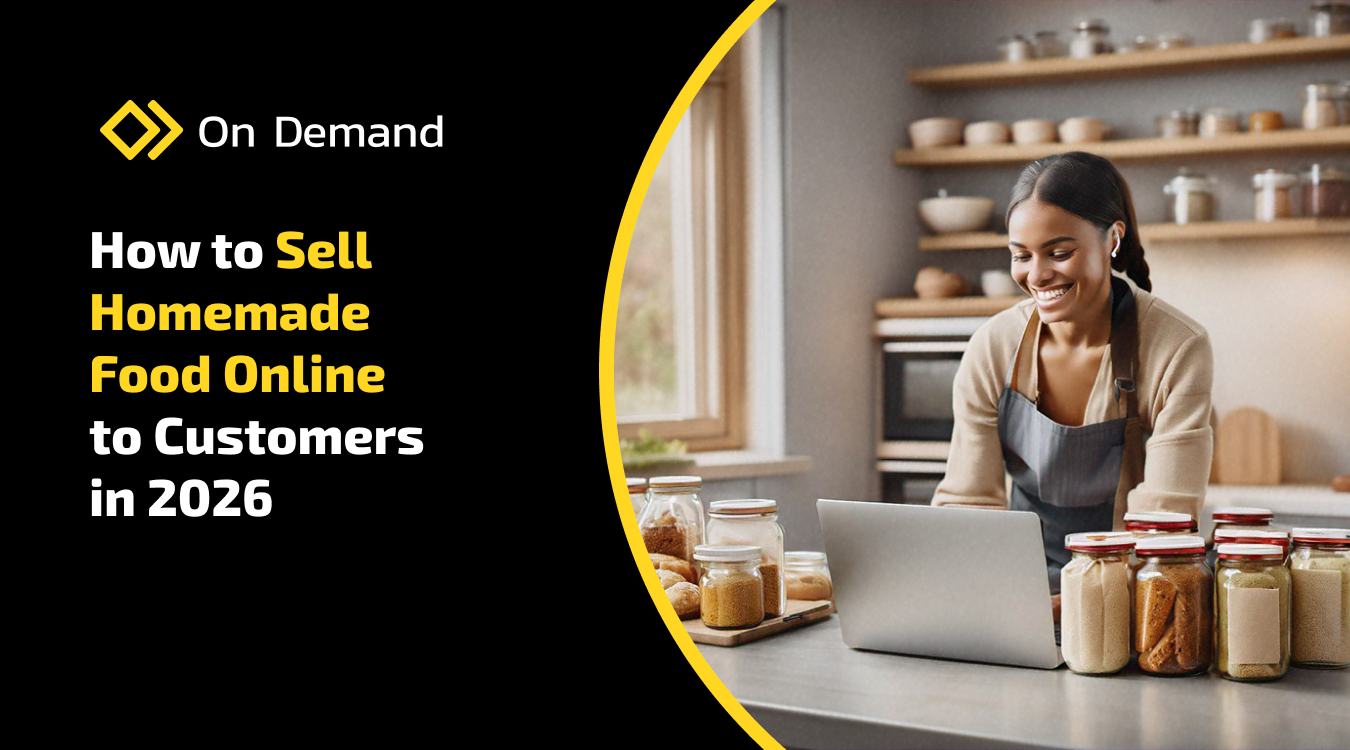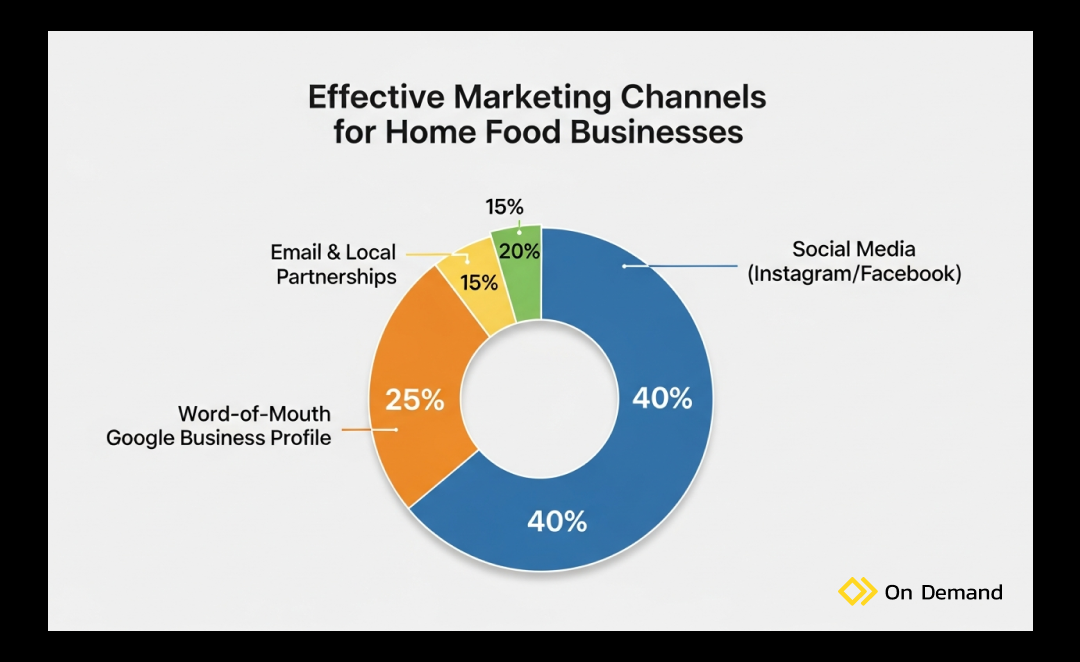Posted At: Nov 06, 2025 - 347 Views
10 minutes to read

The dream of turning a beloved family recipe into a thriving business is more attainable today than ever before. The clatter of pots and pans in your home kitchen could be the soundtrack to your new entrepreneurial journey. But as we look towards 2026, the landscape for selling homemade food online in Canada is evolving. It’s no longer just about having a great product; it’s about navigating a digital-first marketplace, understanding new consumer behaviors, and leveraging technology to your advantage.
If you’re a passionate home cook wondering how to sell homemade food online, this comprehensive guide is for you. We will walk you through the essential steps, future trends, and strategic decisions you need to make to launch and grow a successful homemade food business online in 2026.
The 2026 Opportunity: Why Your Kitchen is the Next Big Restaurant
The demand for authentic, locally-sourced, and unique food experiences is skyrocketing. Consumers are actively seeking out meals made with care and passion. The global online food delivery market is projected to grow significantly, with some forecasts predicting it will exceed $400 billion by 2026 [Source:- towardsfnb.com]. A growing segment of this market belongs to home cooks like you.
This shift is powered by:
- A Craving for Authenticity: Customers Want to Know the Story Behind Their Food.
- The Rise of Niche Diets: Gluten-free, vegan, keto, and other specialized diets create perfect opportunities.
- Technology & Logistics: New platforms and delivery services are making it easier than ever to manage a homemade food delivery business.
Step 1: The Foundation – Your Business Plan and Niche
Before you preheat the oven, you need a solid plan. The most successful food businesses don't just cook well; they plan meticulously. This is the cornerstone of any good home-based food business guide 2026. Your business plan is your roadmap, outlining your mission, menu, target audience, and financial goals.
Find Your Niche and Perfect Your Menu
Ask yourself:
- What am I passionate about? Your enthusiasm will be your best marketing tool.
- What can I make consistently and at scale? A complex 12-hour recipe might not be feasible for 50 orders a week.
- What problem am I solving? Are you providing healthy lunches for busy professionals, decadent desserts for special occasions, or allergen-free treats?
Here are some food business ideas for home cooks to get you started:
| Niche Category | Example Ideas | Target Audience |
| Dietary & Health-Focused | Vegan meal prep, Keto-friendly baked goods, Low-FODMAP meals | Health-conscious individuals, people with dietary restrictions |
| Gourmet & Specialty | Artisan sourdough bread, Small-batch gourmet jams, Hand-crafted pasta | Foodies, people hosting dinner parties, gift-givers |
| Comfort & Family Meals | Weekly lasagna subscriptions, Hearty soup packages, Weekend BBQ kits | Busy families, professionals, students |
| Cultural & Regional | Authentic regional Indian curries, Traditional Mexican tamales | Expats, culturally curious food lovers, and community groups |
A Taste of Pricing Strategy
Pricing is more than a gut feeling. To be profitable, you must calculate it correctly.
- Cost of Goods Sold (COGS): Calculate the exact cost of all ingredients for one unit of your product.
- Labor: Pay yourself! Estimate the time it takes to produce, package, and sell, and assign an hourly wage.
- Overhead: Factor in a portion of your utilities, packaging costs, website fees, and marketing expenses.
- Profit Margin: After covering all costs, add a percentage for profit (typically 20-50% or more, depending on the product).
Formula: (COGS + Labor + Overhead) + Profit Margin = Your Final Price
Step 2: The Legal Recipe – Licenses, Permits, and Regulations
This is the most critical and often intimidating step. You cannot sell homemade food online without adhering to local laws. Regulations vary dramatically by location.

For a homemade food business in the USA, most states operate under "Cottage Food Laws," which allow for the sale of "low-risk" foods (e.g., baked goods, jams, dry mixes) made in a home kitchen. Key things to check are annual sales caps, product restrictions, and labeling requirements.
For those looking to Sell Homemade Food Online in Canada:
Regulations are set provincially. Whether you want to start a food business from home in Ontario or British Columbia, you must contact your local Public Health Unit for guidelines on safe food handling, kitchen requirements, and permitted products.
Actionable Checklist:
- Google Your Location: Search for "[Your State/Province] cottage food laws."
- Contact Your Local Health Department: This is your most reliable source.
- Get Certified: Obtain a Food Handler's Certificate.
- Register Your Business: Register a business name and get the necessary local licenses.
- Look into Insurance: Protect your assets with business liability insurance.
Step 3: Your Digital Kitchen – Website and Platforms
Now for the "online" part of your online business for homemade food. For many, the ultimate goal is to start a food-selling website of their own using a platform like Shopify or Squarespace. A dedicated website offers total brand control and looks more professional.
When building your site, ensure it includes these essential pages:
- Homepage: A visually appealing welcome with your value proposition.
- Menu/Products: High-quality photos, detailed descriptions, prices, and ingredients.
- About Us: Your story! Connect with customers on a personal level.
- FAQ (Frequently Asked Questions): Proactively answer questions about delivery, ingredients, order deadlines, and food safety.
- Contact Us: A simple form and contact details.
Alternatively, food-specific marketplaces (like Castiron) or social media shops can be great starting points.
Step 4: Mastering Visuals and Branding
When you sell food online, people eat with their eyes first. High-quality photos are non-negotiable.
- Use Natural Light: It’s the best and cheapest light source.
- Master Your Smartphone: Use portrait mode to make your food pop.
- Embrace Video: Create short Reels or TikToks of you cooking, packaging, or the finished product. This content is highly engaging and builds trust.
Your branding is your story. Weave this narrative into your website, social media, and packaging to build a loyal community.
Step 5: Streamlining Operations – Orders, Payments, and Delivery
Efficient operations are the secret to a stress-free business and happy customers.
Order Management
How will you track incoming orders?
- Beginner: A well-organized spreadsheet can work initially.
- Scaling Up: E-commerce platforms like Shopify have built-in order management. Food-specific marketplaces also handle this for you. Don't let orders fall through the cracks!
Secure Payment Processing
You need a reliable way to get paid online. Integrated payment gateways are essential for a professional look and for security. Popular options include:
- Stripe
- PayPal
- Square
These easily connect to most website builders and marketplaces.
Flawless Packaging and Delivery
Your job isn’t done when the food is cooked.
- Packaging: Use food-safe, tamper-evident containers. A simple branded sticker elevates the customer experience.
- Delivery: For a local homemade meal delivery startup , consider self-delivery to start, then explore hyperlocal couriers. This model is popular for homemade food delivery in Vancouver/Toronto , where density makes it efficient. Scheduled customer pick-ups are another great, low-cost option.
Step 6: Marketing – Getting the Word Out
You’ve done the hard work; now it’s time to find your customers.

- Hyperlocal SEO: Optimize your website and create a Google Business Profile for terms like "homemade meals in [Your City]." According to recent studies, nearly 46% of all Google searches are seeking local information.
- Content is Your Secret Ingredient: Share the story behind a recipe, provide a cooking tip, or show a behind-the-scenes video to build a community.
- Engage on Social Media: Run contests and partner with local micro-influencers.
- Build Your Email List: This is crucial! Use a signup form on your site to capture emails. Send weekly menus, special offers, and stories to drive repeat business. An existing customer is far easier to sell to than a new one.
Hungry for more? Learn how to price your homemade food for maximum profit and sustainable growth.
Read our guide on "Menu Costing for Home Food Businesses".
Conclusion: Your Future Starts Now
The path to a successful start of a food business from home in Ontario / British Columbia combines passion, planning, and understanding of the digital landscape. From planning and legal compliance to operations and marketing, your home kitchen can become a beloved local brand.
By crafting a solid plan, diligently navigating the legal requirements, building a professional online presence, and mastering your operations and marketing, you can transform your home kitchen into a beloved local brand. The demand for authentic, lovingly prepared food is only growing.
Frequently Asked Questions (FAQ)
Q: Do I need a commercial kitchen to sell homemade food online?
A: Not always. Most states/provinces have "Cottage Food Laws" that allow you to use your home kitchen for "low-risk" foods like baked goods, jams, and candies, as long as you meet safety and labeling standards. Always check with your local health authority.
Q: What are the most profitable homemade food items to sell?
A: Generally, items with low-cost ingredients and a high perceived value do well. Think specialty baked goods (e.g., gourmet cookies, custom cakes), niche dietary meals (vegan, keto), and artisan products like bread or jams.
Q: Can I ship my homemade food?
A: This depends entirely on your local laws and the type of food. Cottage food laws in some areas restrict sales to direct, in-person delivery. Shipping adds complexity with temperature control and durability. Start with local delivery and explore shipping once your business is established and you've confirmed it's legally permissible.


